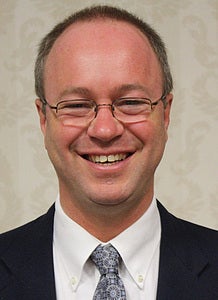Claude Mertzenich

Biography
Education: Ph.D., Inorganic Chemistry, University of Wisconsin; B.A., Chemistry, Carthage College
Claude Mertzenich is an associate professor in the chemistry department. Some of his course topics include Chemical Principles, Inorganic Chemistry, The Essentials of Chemistry, and The Environment: A Chemical Perspective. Professor Mertzenich is a member of the American Chemical Society (ACS); ACS is a Congressionally chartered independent membership organization which represents professionals at all degree levels and in all fields of chemistry and sciences that involve chemistry.
“It is almost impossible to become a chemist in less than three or four years of constant application.” Antoine Lavoisier, Elements of Chemistry, 1790.
- Chemistry 114: The Environment: A Chemical Perspective
- Chemistry 141: Essentials of Chemistry
- Chemistry 151: Chemical Principles I
- Chemistry 152: Chemical Principles II
- Chemistry 373: Solid State Chemistry 2020
- Ph.D., Inorganic Chemistry, University of Wisconsin-Madison, 1991
- B.A., Chemistry, Carthage College, 1985
Nature performs synthetic chemistry in a fundamentally different way than laboratory chemists (e.g. organic chemists). Specifically, Nature uses large macromolecules, in the form of enzymes, to organize substrates in an appropriate position for a chemical reaction. The substrates are generally organized using weak forces such as hydrogen bonds. A major advantage of using the enzyme approach is selectivity since an enzyme orchestrates a highly specific reaction to yield a product with a specific stereochemistry. Such an outcome is a consequence of a high level of organization between reagents and substrates within the enzyme.
In contrast to enzymes, laboratory chemists allow molecules to randomly and freely diffuse in solution and, thus, react in a variety of orientations. This leaves open an opportunity for many side products to form. A clear advantage that a chemist has over Nature, however, is the fact that a chemist can freely decide upon the types of molecules that undergo the reaction. In order to minimize the formation of byproducts and to maximize the yields, synthetic chemists are developing methodologies that allow mimicking Nature’s synthetic strategies (i.e. using templates in form of enzymes to arrange molecules for reaction).
Although templates were proven to work in solution, the use of templates in the solid state remained relatively unexplored. Professor Leonard R. MacGillvray, my collaborator in the chemistry department at the University of Iowa, has developed a method that allows orienting molecules in the highly organized environment of the solid state to undergo a [2+2] photodimerization. To do so, principles of crystal engineering and the use of templates in the form of small molecules are utilized. Specifically, the template molecules effectively act as a molecular equivalent of hands that position reactant molecules in close proximity and in parallel arrangement to form a molecular assembly. The molecular assembly is present as a crystalline solid. When light is shone upon the assembly, the reactants undergo conversion to the product, shown on the right side of the arrow in reaction (1). This process is quite unusual both in Nature and in chemistry, as it takes place in 100 percent yield and in the absence of solvents. This also makes this work an excellent example of green chemistry, wherein the use of organic solvent is eliminated.
Research in our group involves the preparation of product molecules much like the one shown in reaction (1) below.
It has already been shown that the product molecule can be separated easily from the template molecules. The product molecule can then serve as a building block for applications in the field of inorganic chemistry; specifically, for the design and synthesis of metal-organic frameworks (MOFs) with functionalized cavities. This is a class of porous solids that is able to accommodate molecules as guests.
As of 2008, students Phil Bear (Luther ’06), Solomon Gould (Luther ’06), Phuong V. Dau (Luther ’10), Kyle Lilly (Luther ’09), Thandeka Ndlangamandla (Luther ’11), and Ryan Anderson (Luther ’12) have worked with Professor Mertzenich to evaluate template-directed synthesis and metal-organic frameworks in collaboration with Professor MacGillivray’s University of Iowa group.
Above, Prof. Mertzenich as invited plenary speaker, Illinois-Iowa Section of the American Chemical Society 2013 Undergraduate Research Conference (http://ilia.sites.acs.org/2013undergradresearch.htm), “Energy and the Need for Fundamental Research.”
Links
- See this fantastic website showing glassware and other equipment for the modern synthetic research laboratory.
- SciFinder
- Inorganic Syntheses
Degrees Received
- Ph.D. – Inorganic Chemistry, University of Wisconsin-Madison, Madison, Wisconsin, 1991, under the direction of Professor Arthur B. Ellis.
- B.A., Chemistry, Carthage College, Kenosha, Wisconsin, 1985.
Employment history
- Luther College, Decorah, Iowa, 1990-present.
- Associate Professor of Chemistry, 2000-
- Assistant Professor of Chemistry, 1991-1999.
- Instructor in Chemistry, 1990-1991.
- University of Wisconsin-Madison, Madison, Wisconsin, 1985-1991.
- Research Assistant, 1988-1990.
- Teaching Assistant, 1985-1987.